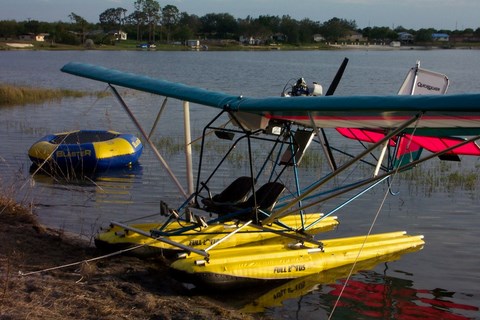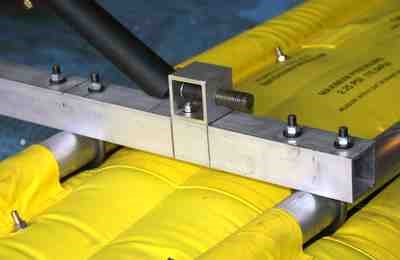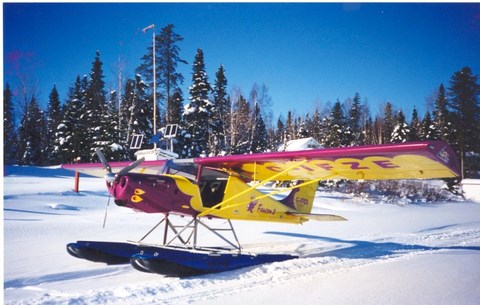Full Lotus Mounts
Spray - Full Lotus floats are very wide and the spray coming off of them isconsiderable. This spray can enter the prop area in a pusher configuration, which will cause loss of thrust, and could result in prop failure.
Many manufacturers and owners of trikes, and other pusher aircraft are now installing splash rails on the side of the floats to help prevent this. In the case of trikes a splash pan such as shown here can be installed.
The other problem area is the tail section, of craft that are mounted low on Full Lotus floats, with the tail section directly to the side or behind the float. For demonstration purposes picture a spray of water 2 feet wide coming off the floats and hitting the tail section at 45 mph.
It is recommended that any water coming off the floats be prevented from striking flight controls such as the horizontal stabilizer, rudder, and elevator.
How to mount the Full Lotus float system on your ultralight aircraft.
Many owners of Beaver's, Quicksilver Challengers, L'il Hustler's, Merlin's, etc. use their original landing gear with some minor modifications.
This requires a lot of fabrication of parts, and drilling of tubing that has to be re-drilled if the floats are not mounted correctly the first time. A simpler installation is to use the original landing gear when possible and install square tubing below it. Then use U bolts to connect your landing gear to the round tubes used on the Full Lotus system.
Using this system no holes need to be drilled into the float tubing or fabric AND the floats can be moved fore and aft by just venting air from the float and then refilling them in the required position.
Full Lotus Floats - Drag
Drag - Pilot's report lower climb rates when flying on Full Lotus floats versus aluminum, fiberglass, composite or wood floats.
They also report needing higher rpm settings to fly at the same speed on Full Lotus floats versus more the more aerodynamic shaped fiberglass and aluminum floats.
On two identically powered and propped Challenger aircraft one flying on Full Lotus floats the other on Puddle Jumper floats the climb rate for the Full Lotus equipped craft was 25% less, and the cruise rpm had to be increased to 6400 from 5800 to maintain the same airspeed.
The other problem is that most Challenger float installations make use of the landing gear to mount the floats. This puts the tail section directly in the path of the spray coming of the floats. Which decreases take off performance and can lead to structural damage to tail supports, and control systems.
Two systems that work considerably better on the Challenger are the Puddle Jumper float, and the Key West Float system, with my preference being for the Key West.



